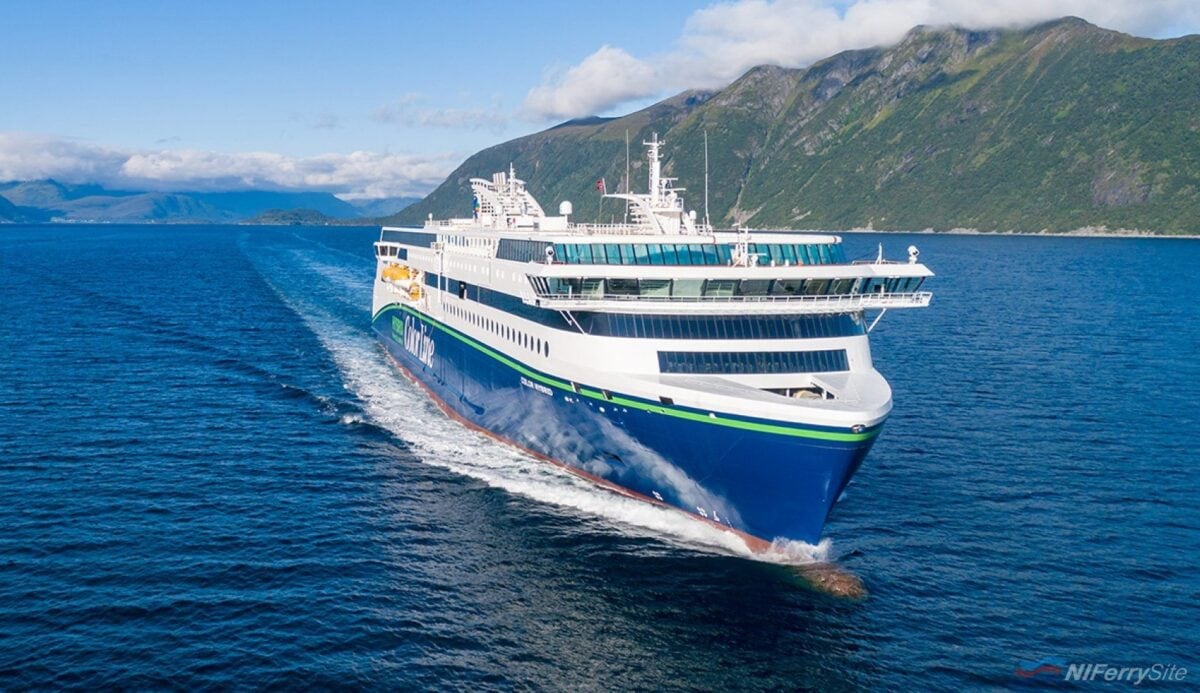Wärtsilä Corporation and Brittany Ferries have announced that the forthcoming new Portsmouth – Saint Malo ferry will be the largest hybrid vessel to date when delivered in 2024. Named SAINT-MALO after the French port she will serve, the new ferry is one of three LNG-Electric hybrid Stena E-Flexer Ro-Pax ferries ordered by Stena RoRo for use by Brittany Ferries and Marine Atlantic.
SAINT-MALO’s third generation 11.5 MWh electrical energy storage solution will be the largest in the world. It will be charged by plugging in to new charging facilities which will be installed at Portsmouth and Saint Malo during redevelopment works at both ports.
In a sign of how fast technology is developing, SAINT-MALO’s Leclanché Navius MRS-3 storage system will have more than twice the capacity of the system on COLOR HYBRID. That vessel was previously billed as the world’s largest plugin hybrid. SAINT-MALO will be almost 35 metres longer than COLOR HYBRID.

The as-yet unnamed new vessel for Brittany Ferries’ Portsmouth – Caen (Ouistreham) route will have the same energy storage system as SAINT-MALO. The other hybrid E-Flexer currently on order, for charter by Marine Atlantic, will have a lower capacity version of the system.
Wartsila will supply the entire propulsion for all three hybrid E-Flexer ferries. The Finnish company’s scope of supply will include the Wärtsilä 46DF main engines, Wärtsilä 20DF auxiliary engines, gearboxes, controllable pitch propellers, thrusters, gas supply system, energy management system, a NACOS navigation and automation system, and an integrated alarm and monitoring system. The energy storage system will be manufactured by Leclanché with the batteries produced at its factories in Germany and Switzerland.

Upgrade ready
According to Per Westling, Managing Director of Stena RoRo, the new vessels will be able to be upgraded to newer technologies in the future:
“Stena wants to be a frontrunner in decarbonising our fleet and, together with our partners, pushing developments towards zero emission operations,”
“Hybridisation allows our vessels to be highly flexible as we adapt to future technology developments, including green fuels, fuel cells, bigger batteries, and solar or wind supported propulsion.”
Unlike other hybrid ferries such as COLOR HYBRID, the new E-Flexer ships will be able to operate at full power in zero-emission electric mode. Håkan Agnevall, President & CEO of Wärtsilä, says:
“Hybridisation is one way of shaping decarbonisation of the marine industry. This order further strengthens Wärtsilä’s leadership in the hybrid segment. The extensive battery size will allow the vessels to operate with full power, using both propellers and all thrusters to manoeuvre emissions-free in and out of ports, even in bad weather. The built-in shore power solution will charge the batteries while berthed,”

SAINT-MALO will be the most modified example of the E-Flexer platform to date when she is delivered in late-2024. While SAINT-MALO won’t be the first hybrid in the series (that distinction goes to the Marine Atlantic vessel, which is already under construction), she will be the first to have an entire additional passenger deck. This will occupy deck 6 on the vessel which was part of the upper freight deck on previous E-Flexer’s. While this will significantly reduce the freight capacity of the vessel, it will allow significantly more cabins to be fitted as well as giving the designers more options with the layout of the passenger decks.
A First for Brittany Ferries
SAINT-MALO is due to replace the oldest vessel in the Brittany Ferries fleet, BRETAGNE, ahead of the 2025 season. She will be the first LNG-Electric hybrid ferry in the Brittany Ferries fleet.

A part sister-ship for the Portsmouth – Caen (Ouistreham) route will be delivered during 2025 to replace NORMANDIE. Brittany Ferries already has two E-Flexer ferries in operation, GALICIA and SALAMANCA, with a third, SANTOÑA, entering service next year.
Brittany Ferries E-Flexer comparison
| Galicia | Salamanca / Santona | Saint-Malo | Normandie Replacement | |
| Length | 214.5 m | 214.5 m | 194.7 m | 194.7 m |
| Passengers | 1,015 | 1,015 | 1,290 | 1,310 |
| Cabins | 343 | 340 | 386 | 220 |
| Freight units | Up to 155 (3,100 lane metres) | 2,758 lane metres | Up to 63 (approx. 1,100 lm) plus a separate deck for passenger cars | Up to 120 (approx, 2,100 lm) |
| Propulsion | Diesel mechanical (with exhaust gas scrubbers) | LNG mechanical | LNG electric plugin hybrid | LNG electric plugin hybrid |
| Engines | 2 x 12,600 kW Caterpillar MaK 12 M43 diesel engines (upgradeable to dual-fuel) | 2 x 13,740 kW Wärtsilä 12V46DF dual-fuel engines | 2 x 13,740 kW Wärtsilä 12V46DF dual-fuel engines | 2 x 13,740 kW Wärtsilä 12V46DF dual-fuel engines |
| Service Speed | 22 kts | 23 kts | 23 kts | 23 kts |
| Delivery | 2020 | 2022 / 2023 | Late 2024 | 2025 |
Please note that the specification of yet to be completed ships may be subject to change.
